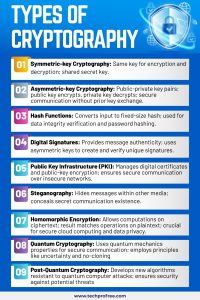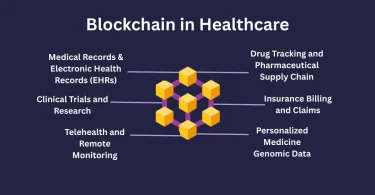Cryptography serves as a method for safeguarding information and communication by employing codes, ensuring that only the intended recipient can comprehend and process it, thereby preventing unauthorized access. Mathematical concepts and techniques are used in this subject to modify messages in ways that make decoding difficult. These algorithms play an essential role in creating cryptographic keys and digital signatures, as well as preserving data privacy for activities such as online browsing and protecting secret transactions such as credit card payments.
Techniques Employed in Cryptography:
Encryption is the process by which regular plaintext turns into ciphertext in cryptography. The recipient has the capacity to decode this ciphertext back into plaintext, this process is known as decryption.
Key Characteristics of Cryptography:
- Ensures that information is only accessible to the intended recipient and that unauthorized access is avoided.
- Integrity ensures that information remains unaltered during storage or transfer, with any changes recognized.
- Prevents the creator/sender from subsequently disputing their purpose to send information.
- It validates the identities of the sender and receiver, along with confirming the origin and destination of the information.

Types of Cryptography:
Broadly categorized, there are three types of cryptography, these are here…
- Symmetric Key Cryptography: In this encryption plan, both the sender and the receiver encrypt and decrypt messages using a shared key. While efficient, the challenge is safely exchanging these keys. Two widely used symmetric key cryptography schemes are the Data Encryption Standard (DES) and the Advanced Encryption Standard (AES).
- Hash Functions: Hash functions generate fixed-length hash values from plaintext, making reverse-engineering the original material difficult. These functions are extensively used in encrypting passwords for operating systems and work without the use of a key.
- Asymmetric Key Cryptography: In this approach, a set of keys are utilized for both encryption and decryption purposes; a public key for encryption and a private key for decryption. Even if the public key is accessible to others, only the designated recipient possessing the private key can decipher the data. The RSA algorithm is a well-known mechanism for asymmetric key cryptography.
Applications of Cryptography:
Computer Passwords: Cryptography is essential in computer security, particularly in password management. Before being stored, user passwords undergo a process of hashing and encryption, guaranteeing their unreadable state, even if a hacker manages to access the database.
Digital Currencies: Cryptocurrencies rely on complicated algorithms and cryptographic keys for protecting transactions, making them extremely difficult to tamper with or falsify and preventing fraud.
Secure Web Browsing: Cryptography protects web browsing via protocols such as SSL and TLS. Public key cryptography encrypts data transmitted between web servers and clients, creating a secure channel that protects users from eavesdropping and attacks known as man-in-the-middle.
Electronic Signatures: Electronic signatures which are equivalents to handwritten signatures, use cryptography to create and validate signatures on documents. They are legally enforceable in many countries and are becoming increasingly widespread.
Authentication: Cryptography is essential for various activities such as accessing a bank account, logging into a computer, or using a secure network. Authentication protocols utilize cryptographic techniques to authenticate users’ identities and validate their access permissions.
Cryptocurrencies: Cryptocurrencies such as Bitcoin and Ethereum rely extensively on encryption methods to maintain the integrity of their networks. These digital currencies employ sophisticated algorithms and cryptographic keys to ensure the overall security and authenticity of every transaction made within their systems.
End-to-End Encryption: Used in communication apps like WhatsApp and Signal; end-to-end encryption secures two-way communications like video conversations and instant messages. It ensures that only intended recipients can read encrypted messages, ensuring high levels of security and privacy.
Advantages of Cryptography:
- Cryptography facilitates access control by making sure that only authorized individuals with the correct decryption key can access specific resources.
- It is essential for secure online communication because it provides reliable methods for communicating sensitive information like passwords and bank account numbers over the Internet.
- Cryptography contributes to the defense against many assaults, such as replay and man-in-the-middle attacks. It offers methods for detecting and preventing these attacks, thereby enhancing overall security measures.
- Cryptography also helps organizations meet legal obligations such as data protection and privacy regulations, ensuring regulatory compliance.
Conclusion:
In a nutshell, cryptography serves as a strong fortification for our digital world, assuring the confidentiality, integrity, and validity of data transferred across several platforms. This sophisticated discipline encompasses diverse methods, including symmetric key cryptography, hash functions, and asymmetric key cryptography, each serving specific purposes in securing transactions, passwords, and communications. In essence, cryptography remains indispensable in our interconnected digital age, empowering us with the tools to navigate the vast landscape of the internet securely and confidently.




Leave a Comment